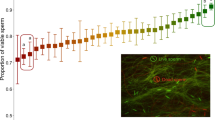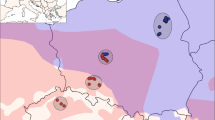Abstract
Females in almost all animal groups copulate with multiple males1,2. This behaviour allows different males to compete for fertilization3 and gives females the opportunity to mediate this competition4. In many animals and most insects, the second male to copulate with a female typically sires most of her offspring1,5,6. In Drosophila melanogaster, this second-male sperm precedence has long been studied7,8,9,10,11,12,13,14,15 but, as in most species, its mechanism has remained unknown. Here we show, using labelled sperm in doubly mated females, that males can both physically displace andincapacitate stored sperm from earlier-mating males. Displacement occurs only if the second male transfers sperm to the female, and in only one of her three sperm-storage organs. Incapacitation can be caused by either fertile or spermless second males, but requires extended intervals between matings. Sperm from different males are not ‘stratified’ in the storage organs but mix freely. Many animal species may have multiple mechanisms of sperm competition like those observed here, and revealing these mechanisms is necessary to understand the genetic and evolutionary basis of second-male sperm precedence in animals.
This is a preview of subscription content, access via your institution
Access options
Subscribe to this journal
Receive 51 print issues and online access
$199.00 per year
only $3.90 per issue
Buy this article
- Purchase on Springer Link
- Instant access to full article PDF
Prices may be subject to local taxes which are calculated during checkout



Similar content being viewed by others
References
Smith, R. L. (ed.) Sperm Competition and the Evolution of Animal Mating Systems (Academic, London, (1984).
Birkhead, T. R. & Møller, A. P. (eds.) Sperm Competition and Sexual Selection (Academic, London, (1998).
Parker, G. A. Sperm competition and its evolutionary consequences in the insects. Biol. Rev. 45, 525–567 (1970).
Eberhard, W. G. Female Control: Sexual Selection by Cryptic Female Choice (Princeton Univ. Press, Princeton, (1996).
Birkhead, T. R. & Møller, A. P. Sperm Competition in Birds: Evolutionary Causes and Consequences (Academic, London, (1992).
Simmons, L. W. & Siva-Jothy, M. T. in Sperm Competition and Sexual Selection (eds Birkhead, T. R. & Møller, A. P.) 341–434 (Academic, London, (1998).
Nonidez, J. F. The internal phenomena of reproduction in Drosophila. Biol. Bull. 39, 207–230 (1920).
Lobashov, M. E. Mixture of sperm in case of polyandry in Drosophila melanogaster. C. R. (Doklady) Acad. Sci. de l'URSS 23, 827–830 (1939).
Kaufmann, B. P. & Demerec, M. Utilization of sperm by the female Drosophila melanogaster. Am. Nat. 76, 445–469 (1942).
Lefevre, G. & Jonsson, U. B. Sperm transfer, storage, displacement, and utilization in Drosophila melanogaster. Genetics 47, 1719–1736 (1962).
Newport, M. E. A. & Gromko, M. H. The effect of experimental design on female receptivity to remating and its impact on reproductive success in Drosophila melanogaster. Evolution 38, 1261–1272 (1984).
Scott, D. & Richmond, R. C. Sperm loss by remating Drosophila melanogaster females. J. Insect Physiol. 36, 451–456 (1990).
Scott, D. & Williams, E. Sperm displacement after remating in Drosophila melanogaster. J. Insect Physiol. 39, 201–206 (1993).
Harshman, L. G. & Prout, T. Sperm displacement without sperm transfer in Drosophila melanogaster. Evolution 48, 758–766 (1994).
Gilchrist, A. S. & Partridge, L. Male identity and sperm displacement in Drosophila melanogaster. J. Insect Physiol. 41, 1087–1092 (1995).
Gromko, M. H., Gilbert, D. G. & Richmond, R. C. in Sperm Competition and the Evolution of Animal Mating Systems (ed. Smith, R. L.) 371–426 (Academic, London, (1984).
Imhof, M., Harr, B., Brem, G. & Schlötterer, C. Multiple mating in wild Drosophila melanogaster revisited by microsatellite analysis. Mol. Ecol. 7, 915–917 (1998).
Gromko, M. H. & Markow, T. A. Courtship and remating in field populations of Drosophila. Anim. Behav. 45, 253–262 (1993).
Gromko, M. H., Newport, M. E. A. & Kortier, M. G. Sperm dependence of female receptivity to remating in Drosophila melanogaster. Evolution 38, 1273–1282 (1984).
Santel, A., Winhauer, T., Blümer, N. & Renkawitz-Pohl, R. The Drosophila don juan (dj) gene encodes a novel sperm specific protein component characterized by an unusual domain of a repetitive amino acid motif. Mech. Dev. 64, 19–30 (1997).
Snedecor, G. W. & Cochran, W. G. Statistical Methods (Iowa State Univ. Press, Ames, (1967).
Sokal, R. R. & Rohlf, F. J. Biometry (Freeman, New York, (1995).
Nachtsheim, H. Eine Method zur Prüfung der Lebendauer genotypisch verschiedener Spermien bei Drosophila. Verhandl. V. Intern. Kongr. Verebungsw., 1143–1147. Z. Ind. Abst. Vereb (Suppl. II) (1927).
Rice, W. R. Sexually antagonistic male adaptation triggered by experimental arrest of female evolution. Nature 381, 232–234 (1996).
Clark, A. G. & Begun, D. J. Female genotypes affect sperm displacement in Drosophila. Genetics 149, 1487–1493 (1998).
Clark, A. G., Begun, D. J. & Prout, T. Female × male interactions in Drosophila sperm competition. Science 283, 217–220 (1999).
Price, C. S. C. Conspecific sperm precedence in Drosophila. Nature 388, 663–666 (1997).
Coyne, J. A., Aulard, S. & Berry, A. Lack of underdominance in a naturally occurring pericentric inversion in Drosophila melanogaster and its implications for chromosome evolution. Genetics 129, 791–802 (1991).
Ingman-Baker, J. & Candido, E. P. Proteins of the Drosophila melanogaster male reproductive system: two-dimensional gel patterns of proteins synthesized in the XO, XY, and XYY testis and paragonial gland and evidence that the Y chromosome does not code for structural sperm proteins. Biochem. Genet. 18, 809–828 (1980).
Kiefer, B. I. Ultrastructural abnormalities in developing sperm of X/O Drosophila melanogaster. Genetics 54, 14441–1452 (1966).
Acknowledgements
We thank M. DeAngelis, C. Gronlund, C. Kim, C. Mercader, J. Posluszny and A.Travelli for technical assistance; A. Santel for the dj GFP II/Cyo flies; A. James and R. Snook for miscellaneous help; B. Robbins for supplies; and A. Civetta, T. Prout and C.-I. Wu for comments. This work was supported by an NSF predoctoral fellowship, NIH genetics training grant and NSF doctoral dissertation improvement grant to C.S.C.P. and by an NIH grant to J.A.C.
Author information
Authors and Affiliations
Corresponding author
Rights and permissions
About this article
Cite this article
Price, C., Dyer, K. & Coyne, J. Sperm competition between Drosophila males involves both displacement and incapacitation. Nature 400, 449–452 (1999). https://doi.org/10.1038/22755
Received:
Accepted:
Issue Date:
DOI: https://doi.org/10.1038/22755
This article is cited by
-
Replenishment of Drosophila Male Pheromone After Mating
Journal of Chemical Ecology (2024)
-
Expression of Ciona intestinalis AOX causes male reproductive defects in Drosophila melanogaster
BMC Developmental Biology (2017)
-
Polyandry in the medfly - shifts in paternity mediated by sperm stratification and mixing
BMC Genomic Data (2014)
-
Female Pygmy Squid Cryptically Favour Small Males and Fast Copulation as Observed by Removal of Spermatangia
Evolutionary Biology (2014)
-
Identification of ejaculated proteins in the house mouse (Mus domesticus) via isotopic labeling
BMC Genomics (2011)
Comments
By submitting a comment you agree to abide by our Terms and Community Guidelines. If you find something abusive or that does not comply with our terms or guidelines please flag it as inappropriate.



